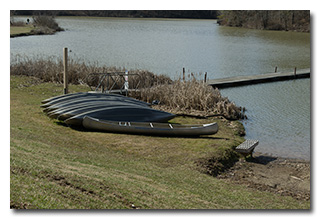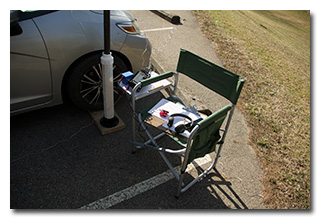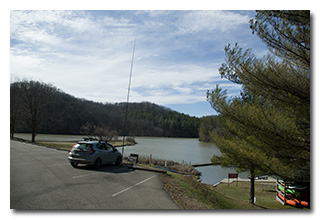
by William Eric McFadden
From the Strouds Run State Park website:
-
Strouds Run State Park is located in the scenic forested hills of Athens County, in the midst of the unglaciated Appalachian Plateau. Although untouched by the vast ice sheets that moved across portions of the state over 12,000 years ago, Strouds Run displays the effects of the glaciers -- in the deep ravines and high hills -- where the valleys served as outlets for torrents of glacial meltwaters. The erosive power of these waters carved the valleys and hillsides, creating the familiar topography Ohioans know today. Large deposits of glacial outwash, primarily sand and gravel, were deposited along these streams and strongly affected the type of biological communities present today.
Sandstone, the principal bedrock outcropping in the region, is very resistant to erosion and forms the uplands and steep sides of the valleys. Twisting roads and forest trails pass through these deep ravines and lead to dense stands of beech, hickory, oak, maple and tuliptree. Seasonal displays are offered by flowering dogwood, redbud and spring wildflowers -- with fall presenting a pageant of colorful foliage. These woods are home to white-tailed deer, fox, raccoon, opossum, squirrel, wild turkey and a variety of songbirds. Woodthrush, white-breasted nuthatch, scarlet tanager, pileated woodpecker and the rufous-sided towhee inhabit the forest canopy. These rugged hills and woodlands are truly reminiscent of the wilderness that characterized the Ohio country in the days of early settlers.
Pictures
Description
 On Sunday, February 12, 2023, one member of the Southeast Ohio Radio Adventure Team
performed a successful activation of Strouds Run State Park (K-1994) as part of the Parks on the Air
(POTA; link) program.
On Sunday, February 12, 2023, one member of the Southeast Ohio Radio Adventure Team
performed a successful activation of Strouds Run State Park (K-1994) as part of the Parks on the Air
(POTA; link) program.
Having made himself a goal of earning in 2023 the Bear Cave Repeat Offender Activator Award by performing sixty activations of the park, Eric McFadden, WD8RIF, visited the swim-beach area at Strouds Run State Park on an unseasonably warm (50°) and sunny mid-February morning to perform his 49th activation of the park. He was accompanied by his little dog, Theo.
Eric arrived at the swim-beach area at around 1650 UTC, found a parking place, and deployed his 28½' wire vertical supported on his 31' Jackite telescoping fiberglass mast and drive-on base. Because the weather was so pleasant, Eric decided to operate al fresco and deployed his KX3 on his folding camp-chair next to the Jackite mast. Eric was on the air at 1704 UTC.
As expected, Eric found he had good cell-signal at this location and, after earlier in the morning spending almost forty-five minutes with TracFone tech-support, he again had working internet-over-cell and would be able to spot himself on the POTA Spots website and to use POTA Spots to identify possible Park-to-Park (P2P) QSOs.
Eric began his operation on 20m by selecting a frequency to run and calling "CQ". Eric's first QSO came at 1705 UTC with KC1MXB in Maine. QSOs came very quickly, with Eric's thirteenth QSO coming at 1716 UTC with KJ7DT in Idaho. This run included a P2P QSO with AI7BM who was activating Helena-Lewis and Clark National Forest (K-4504) in Montana, a P2P QSO with N1BS who was activating Big River Wildlife Management Area (K-6982) in Rhode Island, and QSOs with operators located in Maine, Tennessee, Kentucky, Pennsylvania, North Carolina, Mississippi, South Carolina, New Jersey, Montana, Michigan, Illinois, Rhode Island, and Idaho.
Eric closed out his activation by checking POTA Spots for P2P QSO opportunities and at 1719 UTC he completed a P2P QSO on 20m with N4CD who was activating his home-park of Spring Creek Forest State Preserve (K-4423) in Texas, which he has previously activated 265 times.
In all, Eric made fourteen QSOs, including three P2P QSOs in fifteen minutes of on-air time. All of Eric's QSOs were CW and were made at five watts output.
Eric also submitted his log to the World Wide Flora and Fauna in Amateur Radio (WWFF; link) program for an operation at Strouds Run State Park, KFF-1994.
(return)

